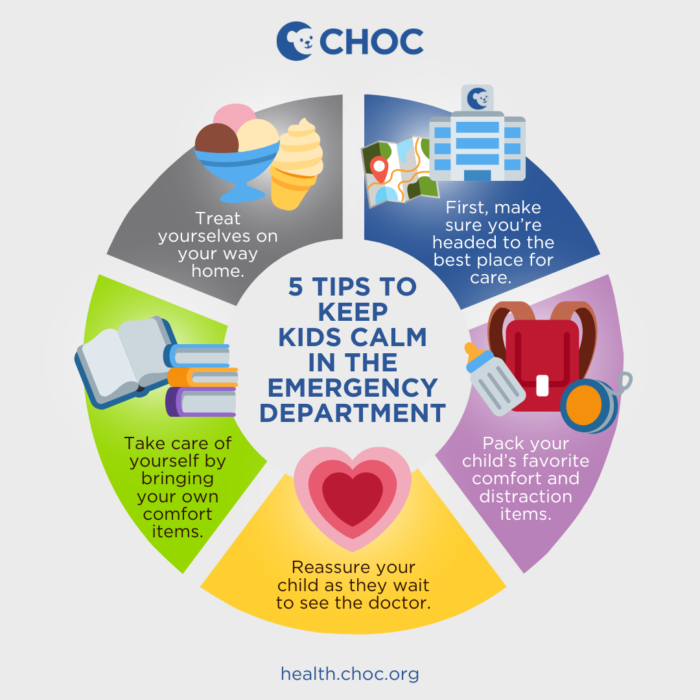When your child visits an emergency department (ED), urgent care, primary care office, or specialist, you will likely wait before a doctor sees them.
Even with doctors and nurses working hard to see patients quickly, you may wait anywhere from minutes to hours, especially when hospitals, urgent care centers, and doctors’ offices are busy.
Ariel Craig and Melissa Kawanka, child life specialists at the Cherese Mari Laulhere Child Life Department, work with families at CHOC at Mission Hospital to help ease the hospital or doctor’s office experience that can sometimes be stressful or scary.
During March’s Child Life Month, we honor our professionally trained child life specialists who are dedicated to serving CHOC’s patients and families through therapeutic medical play, pre-surgery preparation and support, sibling support, grief and bereavement support and much more.

Here, Ariel and Melissa offer helpful tips for parents and kids enduring long wait times at the ED, urgent care or doctor’s office.
First, make sure you’re headed to the best place for care
If you think your child is experiencing a life-threatening emergency, do not hesitate to take them to the nearest emergency department immediately.
With so many options available for care like urgent care, your pediatrician’s office or the hospital, knowing where to go isn’t always clear. In CHOC’s “Where to go for care” guide, we map out your options based on your child’s symptoms.
Recently, CHOC — and all children’s hospitals — have been impacted by patients with symptoms caused be like respiratory syncytial virus (RSV), enteroviruses and other respiratory illnesses.
CHOC offers helpful articles on what to expect at the ED during flu season, best practices for preventing respiratory illnesses and how to care for your child with a fever.
Pack your child’s favorite comfort and distraction items
Before you head to your appointment, ED or urgent care (if it’s not an emergency and there is time to spare), consider packing a bag full of your child’s favorite comfort and distraction items.
Ariel and Melissa suggest bringing the following comfort items:
- A favorite toy.
- Pacifier.
- A warm blanket or cozy sweatshirt — in case it gets cold in the waiting room!
- Stuffed animal.
They also suggest the following distraction items:
- Books.
- iPad or tablet – make sure to bring headphones to be respectful of other patients.
- Playing cards.
- Coloring or activity books.
- Stress ball, squishy or fidget toys.

Download or print this graphic
Reassure your child as they wait to see the doctor
Be sure to effectively communicate with your child during long wait times – we know they can be hard on both of you!
Reassure your child that everyone — the doctors, nurses, techs, medical assistants and child life specialists — is there to help support them and help them feel better.
To help calm your child down if they feel nervous or impatient, consider saying the following:
- “Waiting is hard, but the doctors and nurses are busy helping a lot of other kids feel better too.”
- “Some kids have big owies that have to be fixed first before they can help us.”
- “We have to stay in the waiting room so the doctors and nurses know where to find us when it’s our turn to go back into a room.”
You can also give examples to your child about a time that you had to wait a long time, or an experience you had in a hospital or doctor’s office. Explain that after the treatment, everything was OK. Offering physical comfort through hugs or letting them sit on your lap or lean against your shoulder may help during this time, too.
Remember to take care of yourself
Don’t forget to take care of yourself during this time! We know how hard and nerve-wracking it can be to have a sick or hurting child, says Ariel and Melissa.
Use the following tips to ease the stress of a long doctor’s visit:
- Try to stay calm. Children can feel parental anxiety and frustration.
- Bring your own comfort items like a comfortable jacket, books or your tablet.
- Advocate for your child. You know best how they are feeling and what they need.
- Prepare your questions for the doctor ahead of time. Not only will this help you remember to get the information you need, but it can also help speed up getting home.
- Ask for help. The nurses, doctors, techs and child life are there to support you, too.
Treat yourselves on your way home
Once your appointment, procedure or hospital visit is over, consider offering your child an appropriate reward for being patient and calm at the doctor’s office or hospital.
Stop at a store (or the hospital gift shop) to let your child pick out something, pick up takeout from your favorite place or stop for ice cream or dessert on the way home — you both deserve it!
Happy Child Life Month! View the following video to learn more about the Cherese Mari Laulhere Child Life Department at CHOC.
For more health and wellness resources from the pediatric experts at CHOC, sign up for the Kids Health newsletter.
Find a CHOC Primary Care Pediatrician
From babies to teens, pediatricians from CHOC’s Primary Care Network partner with parents to offer immunizations, sick visits, sports physicals and more.





